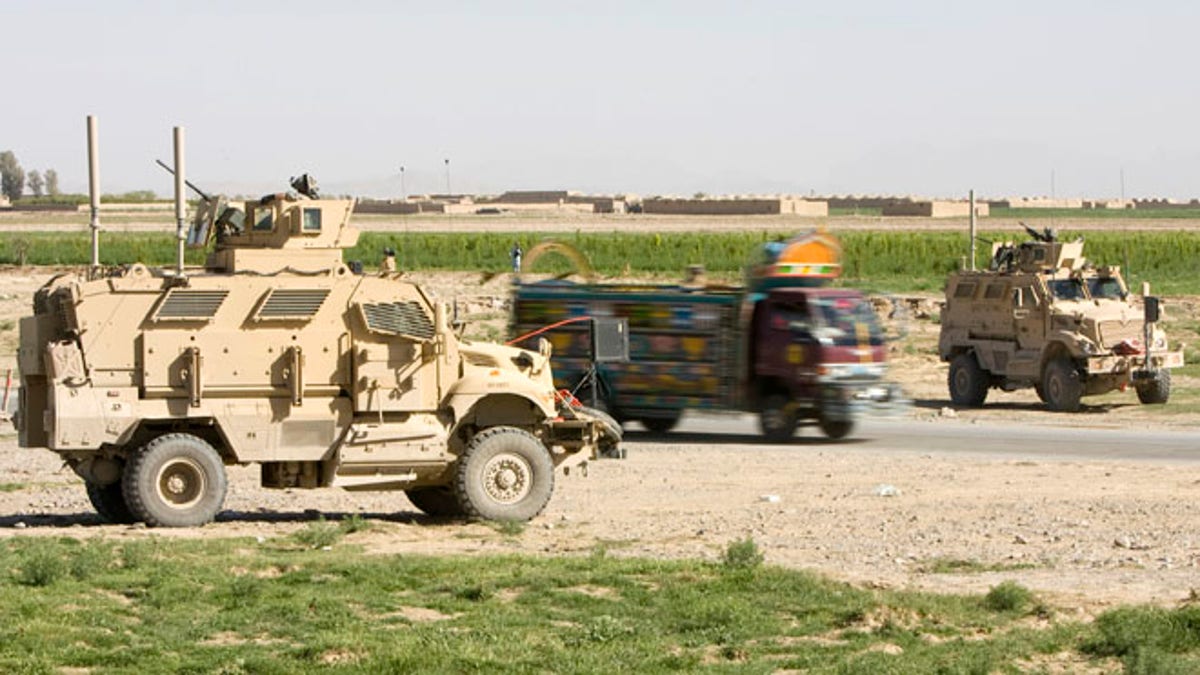
March 25, 2010: An Afghan truck is driven past U.S. Army Mine Resistant Ambush Protected (MRAP) armored vehicles of 508th Special Troops Battalion, 82nd Airborne Division, at an Afghan Police checkpoint on the Highway One, the main Afghan road around the country, outside the town of Kandahar, southern Afghanistan. Police and sheriff's departments in the U.S. have obtained 165 MRAP vehciles leftover from the Iraq war. (Reuters)
QUEENSBURY, N.Y. – Coming soon to your local sheriff: 18-ton, armor-protected military fighting vehicles with gun turrets and bulletproof glass that were once the U.S. answer to roadside bombs during the Iraq war.
The hulking vehicles, built for about $500,000 each at the height of the war, are among the biggest pieces of equipment that the Defense Department is giving to law enforcement agencies under a national military surplus program.
For police and sheriff's departments, which have scooped up 165 of the mine-resistant ambush-protected vehicles, or MRAPS, since they became available this summer, the price and the ability to deliver shock and awe while serving warrants or dealing with hostage standoffs was just too good to pass up.
"It's armored. It's heavy. It's intimidating. And it's free," said Albany County Sheriff Craig Apple, among five county sheriff's departments and three other police agencies in New York that have taken delivery of an MRAP.
But the trucks have limits. They are too big to travel on some bridges and roads and have a tendency to be tippy on uneven ground. And then there's some cost of retrofitting them for civilian use and fueling the 36,000-pound behemoths that get about 5 miles to the gallon.
The American Civil Liberties Union is criticizing what it sees as the increasing militarization of the nation's police. ACLU affiliates have been collecting 2012 records to determine the extent of military hardware and tactics acquired by police, planning to issue a report early next year.
"One of our concerns with this is it has a tendency to escalate violence," said ACLU Center for Justice senior counsel Kara Dansky.
An Associated Press investigation of the Defense Department military surplus program this year found that a disproportionate share of the $4.2 billion worth of property distributed since 1990 — everything from blankets to bayonets and Humvees — has been obtained by police and sheriff's departments in rural areas with few officers and little crime.
After the initial 165 of the MRAP trucks were distributed this year, military officials say police have requests in for 731 more, but none are available.
Ohio State University campus police got one, saying they would use it in large-scale emergencies and to provide a police presence on football game days. Others went to police in High Springs, Fla., and the sheriff's office in Dallas County, Texas.
In Boise, Idaho, police reported using their MRAP two weeks ago to serve a warrant, saying they had evidence the suspect might be heavily armed and have explosives. Authorities said they found 100 pounds of bomb-making material and two guns. A second MRAP from nearby Nampa's police department was used to shield officers and neighbors from a possible explosion.
In New York, the Albany County sheriff's department already had four smaller military-surplus Humvees, which have been used for storm evacuations and to pull trees out of roadways. The new MRAP truck will go into service after technicians remove the gun turret and change the paint from military sand to civilian black.
Sheriff Apple rejected the idea that the nation's police forces are becoming too militaristic.
"Nothing could be further from the truth," he said. "Our problem is we have to make sure we are prepared to respond to every type of crisis."
For example, he said, if SWAT teams need to get close to a shooter or get bystanders safely away from one, the MRAP would be the vehicle of choice.
In Warren County, at the southern edge of the Adirondack Mountains, Undersheriff Shawn Lamouree said its MRAP, which can hold six people and reach 65 mph, will have its turret closed up except for a small slot, the only place to fire a gun. Its bulletproof windows don't open. The proposed retrofit, including new seating, loudspeakers and emergency lights, would cost an estimated $70,000. The department has applied for grants.
"We have no plans of mounting a machine gun," he said. "The whole idea is to protect the occupants."
While Warren County's Lamouree acknowledged the MRAP will likely spend most of its time in a heated garage, with "minimal" maintenance costs, it could be used occasionally by the emergency response team, which has used armored vehicles to serve drug warrants.
"We live in the North Country," he said. "It's very common for people to have high-powered hunting rifles."
In one recent incident, a team used its armored military-surplus Humvee to approach a barricaded suspect, similar to a circumstance in which it might use the MRAP.
"We rolled the Humvee in the front yard, gave a couple of commands and he said, 'OK, I'm coming out," said investigator Jeff Gildersleeve. "That's the way we like them to end."
Others in New York that got big armored trucks included sheriff's departments in Jefferson County, Steuben County and Sullivan County, and police in Nassau County, Plattsburgh and Hamburg Village. Police departments statewide have also acquired almost 150 other trucks and Humvees, a dozen of them armored, over the past two years.

